DPAC Occupy Dept of Work & Pensions
Tothill St, Westminster, London. Fri 31 Aug 2012
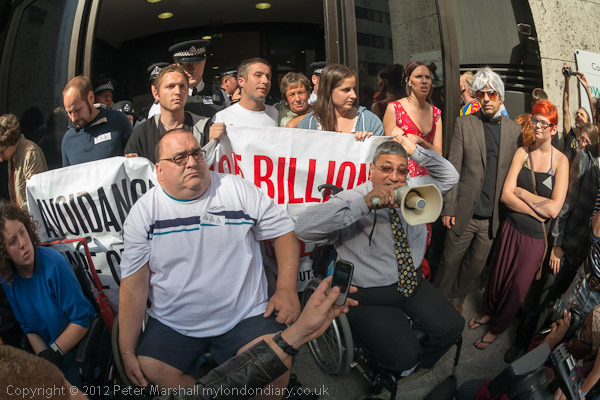
Some DPAC activists were inside the building but
police kept the rest outside the door
more pictures
Disabled activists occupied the Department of Work & Pensions and protesters from the 'Closing Atos Ceremony' came to Westminster to join them outside the offices. Outside, DPAC activist Adam Lotun announced his intention to stand in the Corby by-election.
As the 'Atos Closing Ceremony' appeared to be coming to an end there was an announcement telling people they should hang around, and in ten minutes time there would be a special announcement about another action that was taking place elsewhere that we would want to go on to.
I started trying to find out what was happening, and eventually got the message that disablement activists had just walked in to Caxton House, the home of the Department for Work and Pensions (DWP) in Tothill St in Westminster.
Traffic was heavy in places and it took me around 25 minutes to get there; when I arrived there were around 20 or so protesters outside with banners in front of the entrance. Behind them were a block of around a dozen police in several rows in the fairly narrow outer lobby, and behind them I could see more police and a few protesters.
A couple of minutes after I arrived, the main group which had come from the earlier protest arrived, and several more people in wheelchairs came up in front of the banners, with a large crowd on the pavement and spilling out into the roadway.
Adam Lotun arrived and also came to the front and gave a short address about the actions today and earlier in the week of action against Atos, a fight which would continue. As one way to keep up the campaign he announced that he would stand as an independent candidate in the Corby by-election.
A few protesters decided to try to push through the police so they could meet up with those already in the building. This was difficult as there were a crowd of media people in the way as well as the people in wheelchairs and some other protesters who wanted it to be an entirely peaceful event.
A confused mêlée developed and continued for the next ten minutes or
so, and with police reinforcemnents arriving, the protesters were forced
a few yards back from the actual doorway. There were still protesters
inside the building when I left to catch a train a little before half
past three.
more pictures
Closing Atos Ceremony
Triton Sq, London. Fri 31 Aug 2012
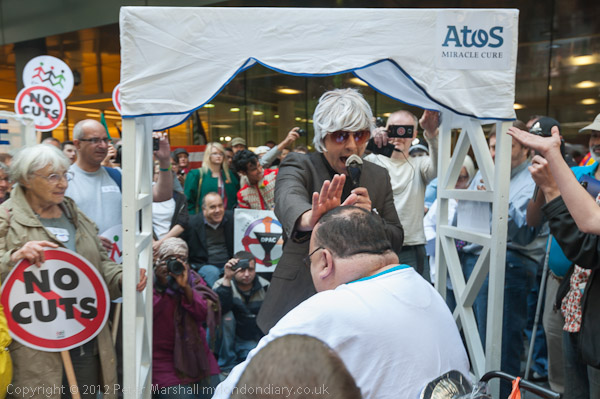
The Atos Miracle Cure renders everyone fit for work
more pictures
As the start of their grand finale to the week of protests around the country against Paralympic sponsor Atos, DPAC and UK Uncut held their Closing Atos Ceremony outside the company's UK Offices with dancing and street theatre.
Disabled People Against the Cuts and UK Uncut had organised the week of action as a protest against the sick spectacle of Atos, the company who pressures its staff to unfairly declare disabled people 'fit for work' to increase its profits and meet government targets, bathing in the glory of sponsoring the Paralympic games.
In London, protests included a spoof opening ceremony next to Tower Bridge with its Paralympic symbol, a vigil at Westminster and a memorial service outside the Atos head office to remember the people who have lost their lives at the hands of Atos Healthcare. In Cardiff campaigners carried out a graphic protest on the same theme, with 40 protesters stopping traffic as the lay in the road to represent the corpses. At the Paralympics opening ceremony inside the stadium, many of the British athletes covered up their lanyards with the Atos name on them as a protest against their involvement as sponsors.
Tara Flood, a former Paralympian who represented GB at three Paralympic games and whose gold-medal winning time at the 1992 Barcelona games remains a world record, reflected the feeling of many disabled people when she stated: "It is a shocking irony that Atos is a main sponsor of London 2012 whilst destroying disabled people’s lives on behalf of the government."
More than 500 people came to Atos's offices in Triton Square for a peaceful protest outside the offices. The mood was very different to Wednesday's solemn service, and there was something of a festival atmosphere, with music and darncing, poppers, brightly coloured plastic water pistols and some fancy dress along the the usual banners and placards, but there was no mistaking the anger against Atos, evident in the slogans on the placards and chanted. 'Atos Kills!' and its target-driven computer-based work capability assessments cause extreme hardship and misery to many disabled - and death to some. Last year 1,100 claimants died after Atos tests placed them on compulsory work-related activity to gain benefits, and a number of those found ‘fit for work’ and left without income have committed or attempted suicide.
One of the protesters carried a poster giving details of Cecilia Burns, declared fit to work by Atos in February, having been given no points for her breast cancer, who died this morning. As it commented, 'Atos is a sick joke.' Another placard listed some of the other conditions that Atos has found to have no bearing on fitness for work, including fatal heart conditions, kidney cancer and severe MS.
There were a couple of pieces of theatre at the event, and the second starred the 'Atos Miracle Cure', and archway through which those disabled people who truly wanted to be freed of their disabilities were urged by 'Atos's own Reverend' to come forward and go through the arch, which a number, mainly in wheelchairs, did. Nothing seemed to happen to them, and they were disappointed, even after the 'Rev' had blessed them and patted them on the head, but then an 'Atos doctor' in a white coat came to assess them, and lo! she gave them each a certificate that they were now fit to work, and, even more miraculous, a job. But unfortuntely the whole thing was a con!
The Closing Atos Ceremony ended with the announcement that disabled
activists had entered and occupied the Department of Work and Pensions
offices, Caxton House, in Westminster. By that time I'd heard a couple
of minutes earlier and was already sitting on a bus on my way there.
more pictures
Disabled Pay Respect to Atos Victims
Triton Sq, London. Wed 29 Aug 2012
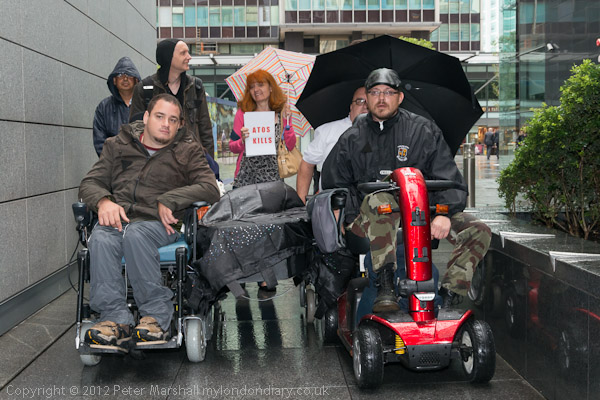
The coffin was carried by wheelchair and mobility vehicle users
more pictures
Disabled activists held a vigil to remember those who have died as a result of the Work Capability Assessments carried out by Paralympic Sponsor Atos, delivering a coffin to their head office on the day the Paralympic Games opens.
It was raining as the activists met in the two coffee shops on Triton Square and began to get ready for their vigil, but soon they were outside in the rain waiting for event to begin. Fortunately they were able to use an area under cover adjoining the Atos offices, where they set up a PA system, an electronic organ, a lectern and an altar.
A short introduction which explained the problems with the Work Capability Assessment delivered by Atos, "a relentless health and disability assessment regime which has been used to slash vital benefits from hundred of thousands of sick and disabled people" and where assessors are told they have to reach strict targets in failing the great majority of claimants, finding ways to fill in the relevant boxes on the forms and often deliberately misinterpreting the claimants responses and misrepresenting their medical condition.
A number of stories where then read out of people who had committed suicide as a result of receiving incorrect assessments by Atos, including only those cases where there was evidence of some kind that the assessment had been a part of the direct cause of their deaths, or had been stated by their families as having been so.
A coffin was then brought by four disabled people in wheelchairs or mobility scooters to where the ceremony was taking place, and people came forward to lay flowers on it. It was then carried the few yards and put down directly in front of the Atos office entrance, and more flower petals were then thrown over it.
The event was a solemn and moving reminder of the scandal of the work capability assessments and the terrible effect they are having on the disabled. Many are losing the allowances that enable them to travel to work, others housing benefits, and are being told they are fit to work when patently they are unable to do so. One of the protesters had a placard with a list of some of the cases, "a suicidal woman - a man with FATAL heart condition - rape survivor of Rwandan genocide - man with kidney cancer - woman with sever MS". It is a list that could be extended almost indefinitely - and now includes a man in a coma.
One of the activists came with a newspaper with a headline about Atos
being "engulfed by disability test row" and it does seem at last that
many people are seeing through the government's attempt to stigmatize
the disabled as benefit scroungers and realise the very real hardship
the removal of benefits is causing. It really is a cruel paradox that at
a time when the nation is celebrating the great achievements of disabled
people in the sporting world, our government is trying to reverse the
moves toward equality of treatment of disabled people, and that the
company that is trying to take the credit for sponsoring the Paralympics
is profiting from contracts to dishonestly deny benefits to the disabled
who need them.
more pictures
Remploy Protest at Stratford
Stratford Station, London. Wed 29 Aug 2012
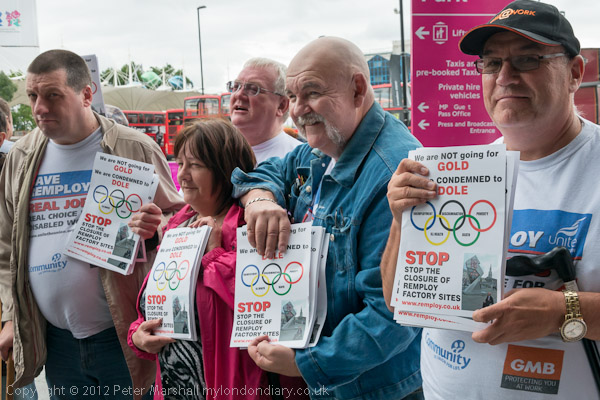
Protesters show their Olympic flyer at Stratford on the day the
Paralympics opened
more pictures
On the opening day of the Paralympic Games, Remploy workers and supporters protested outside Stratford Station following the closure of 27 Remploy factories last week. Few of the disabled workers who lost their jobs will ever work again.
Remploy was established to make it possible for disabled people to do useful and productive work. The nearest factory to the protest at Stratford, Remploy Barking, one of the 27 that was shut down by the government last week, produced printed circuit boards and electrical assemblies, as well as recycling used computers. Remploy enabled disabled workers and those with special health conditions to do useful jobs, providing opportunities that are simply not otherwise available. When some Remploy factories were cut by the previous government, 80% of all the disabled workers were unable to find jobs, and given the current economic position the situation for those who lost thier jobs last week is even bleaker.
Originally Remploy was set up to give jobs to men and women who had been injured fighting for their country in the Second World War - just the kind of ex-servicemen who now make up a significant proportion of our Paralympic Team GB. The protesters, including Phil Davies of the GMB, secretary of the Remploy Consortium of trade unions, handed out an Olympic-themed leaflet pointing out that the "Remploy workers are the most vulnerable in society and will face a lifetime of poverty and in some cases isolation" and calling for the public "not only to support the athletes but also to spare a thought for Remploy disabled workers by writing to the Prime Minister and objecting to how disabled people are being treated."
The front of the leaflet had the text 'We are NOT going for Gold, We are Condemned to Dole' and the five Olympic rings were labelled 'Unemployment, Discrimination, Poverty, Ill Health and Death.
Remploy workers stepped up their actions last week with an occupation
of Remploy’s head office in Leicester last Thursday, only ended when the
disabilities minister Maria Miller promised fresh talks. A five day
strike begins at Remploy Chesterfield next Monday and a four day strike
in Glasgow.
more pictures
Vedanta AGM Protest
Lincoln's Inn Fields, London. Tue 28 Aug 2012

Theatrical blood on the steps leading to the AGM
of mining company Vedanta.
more pictures
A protest took place outside the AGM of Vedanta, owned by billionaire Anil Agarwal, backed by the UK government but opposed by groups in India, Goa, Liberia, Namibia, South Africa and Ireland, Zambia and Sri Lanka for the environmental damage, pollution and human rights abuses caused by its mining of bauxite and other minerals.
The stage blood was a little street theatre in a peaceful protest against the mining company whose activities have been condemned by Amnesty International, and have led to disinvestment by concerned investors including the Norwegian Government Pension Fund, Martin Currie Investments, the Church of England, the Joseph Rowntree Charitable Trust and the Dutch Pension Fund PGGM, but they are still backed by more than 30 major banks and financial agencies including HSBC, RBS, Deutsche Bank, Axa, Royal Bank of Canada, Credit Suisse, J P Morgan Chase, Goldman Sachs, Lloyds Banking Group, Nordea Bank, ICICI, Citigroup, National Bank of Kuwait, ANZ and Merrill Lynch.
The UK Department for International Development (DfID) and Department of Trade and Industry (DTI) helped to launch Vedanta on the London Stock Exchange and through the World Bank funded NGO Business Partners for Development, helped it to take over copper mines in Zambia. Most recently, government officials and David Cameron put pressure on the Indian government to enable Vedanta to take over around 30% of Indian crude oil.
Vedanta's mining and smelting of bauxite in Odisha, India has left over 10,000 displaced people landless, contaminated drinking water and devasted vast areas of formerly fertile land, with famines every year since 2007. Only prolonged resistance by the indigenous Advasi people over seven years has so far prevented the devastation of their sacred Niyamgiri hills.
Another protest in Goa, where a pit wall collapse drowned a village in toxic mine waste in 2009, managed to stop a further iron ore mine. There have been other floods and other mass protests and the Vedanta subsidiary there is accused of large scale fraud and illegal mining.
There have also been many large-scale protests in Tamil Nadu, where, according to 'Foil Vedanta', the Vedanta subsidiary there "has flouted laws without remorse, operating and expanding without consent, violating environmental conditions, and illegally dumping toxic effluents and waste." They allege that "damning court actions" against the company have been overturned on several occasions by "Pollution Control Boards, judges and expert teams" as a result of "large scale corruption and bribery."
I was busy a few yards away and missed seeing the actual throwing of the fake blood, but several protesters went to dip their hands in it and were chased away by security and the one police officer who was then on duty at the event. I think the person who had thrown the blood quickly left the area.
Shareholders arriving for the meeting, including four protesters, among them Bianca Jagger, had to step over the bloody area as they made their way in. Later carpets were brought out from the centre and put down over the blood, until Lincoln House provided their own little vignette of street theatre as a black cleaner was supervised by white staff as she was directed to clean up the mess.
The crowd of around 80 people across the road shouted 'Blood on your hands, Vedanta! Blood on your hands Agarwal! Blood on your hands, Cameron!' They kept up a high level of noise as they knew from previous years - this was the eighth protest at a Vedanta AGM - that they could be heard inside the meeting, and wanted to make their presence felt.
A dozen or so police arrived ten or fifteen minutes later, although there was little for them to do. One man walking past did turn and run up the steps shouting "Blood on your hands!, but was stopped by security and quickly dragged back onto the pavement by police, who pulled him along a bit, but then appeared to let him go.
Half an hour or so later 3 police vans came and parked a short distance
away. By that time many of the protesters had left although the
shareholders were still in the meeting. Police probably outnumbered the
protesters, and I decided little further was likely to happen and it was
time to go.
more pictures
Regrade GCSE English
Westminster, London. Tue 28 Aug 2012
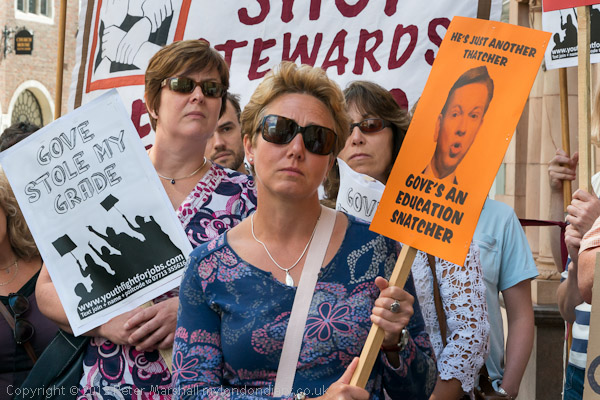
Teachers with placards outside the Dept for Education
more pictures
London teachers protested at the Dept for Education calling for the immediate regrading of GCSE English following the government inspired moving of GCSE grade boundaries that threaten the future of both the students affected and their schools.
The urgent protest was called at the last minute by London teachers, who as well as being appalled by the unfairness of the changes on their students are also worried that the lower results will mean that many schools now fail to reach the 40% A-C benchmark imposed by Education minister Michael Gove, and will be forcibly privatised. Individual teachers may also face 'capability' proceedings and loss of performance-based pay awards as a result of the lower results, even though the actual performance of students has not changed.
The protest was suggested late on Friday night by a young teacher from Lewisham, and rapidly gained support, although teachers are still on their summer vacation and many enjoying their last week away from home. Among the more than 50 people present were several members of the NUT executive and NUT Deputy General Secretary Kevin Courtney.
The protesters carried placards reading 'Gove Stole My Grade' and 'Hey, Michael, Leave Our Kids Alone' and there was Gove's face with a dunces cap. Several of the teachers present spoke, including Kevin Courtney, and a letter was signed to be delivered to the Education Minister calling for the immediate regrading of the English exams. As the teachers stressed, there just isn't time to wait for any inquiry as students and sixth-form colleges will be having to make their decisions for the future in the next couple of weeks.
The action by the exams boards means that many students with exactly the same work who would have gained a Grade C if it had been submitted in January have been downgraded to Grade D. Although GCSE was introduced as a system that would grade students across the whole spectrum with no special significance being attached to the Grade C/D boundary, over the years it has been altered by governments to become a system in which grades A (and now A*) to C are recognised as a pass and grades D and below as failures, both for the students and for their schools.
The protests was not about the marking of the examinations, but at the arbitrary and unfair change in the marks required to get the various grades, and in particular the boundary between grade C and D. Regrading would be a simple administrative exercise that could be done rapidly and at relatively low cost - simply requiring a computer to re-run the batch of results with the grade boundaries used in January rather than the altered set.
The change in the grade boundaries is seen as part of Gove's agenda to blame schools and teachers for 'failing' students and provide a rationale for closing down schools run by democratically elected local councils and replacing extending the privatisation of exducation by their replacement by 'academies.'
Many students who had been hoping to start A level courses in September - even those not studying English - will now fail to get onto their courses as a result of this downgrading, and there are estimates that this could result in a rise of around 10,000 'NEETS', young people currently "not in education, employment, or training." The protest came on the same day that Employment Minister Chris Grayling announced that young unemployed Londoners will be forced to do three months of unpaid full-time work or have their benefits cut.
The downgrading will disproportionately affect students from working
class backgrounds, whose aims to better themselves through education
have already been hit by this government with the removal of EMA, the
educational maintenance allowance for 16-18 year olds, and by the hike
in University fees.
more pictures
Opening Ceremony for the Atos Games
Potters Fields, London. Mon 27 Aug 2012
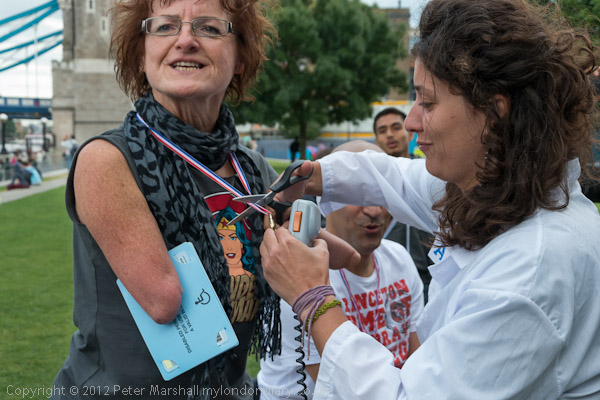
Paralympian gold medal winner Tara Flood is
stripped of her gold medal and blue badge
more pictures
DPAC's week of action against Paralympics sponsor Atos began with Gold medal winning Paralympian Tara Flood getting another gold at the opening ceremony for the Atos Games, but like other medal winners was stripped of it after an Atos assesment showed her fit to work.
Disabled People Against Cuts (DPAC) held a spoof Opening Ceremony for the Atos Games in front of Tower Bridge, which now has the Paralympic symbol hanging from it. The games are a national week of action against Paralympics sponsor Atos, whose computer based 'fitness for work' tests have led to stress, hardship deaths and suicides among the disabled.
Over 50 people, including many in wheelchairs arrived to take part in the protest, which began with a several speeches about the problems caused by Atos assessments which led to this action, as well as mentioning other unsuitable Olympic sponsors such as Dow, still failing to take up their responsibility for the Bhopal disaster, and the scandal of disabled prisoner Daniel Roque Hall, now in intensive care after the failure of Wormwood Scrubs to provide the necessary medical facilities for him.
After a few problems with the breeze, the Atos Games flame was finally lit, although the candle seemed in constant danger of blowing out it did burn for some minutes. Those at the protest then sang the Atos Games song, 'Imagine there's no ATOS' though it wasn't quite clear to me what tune was intended.
The first medals of the Atos Games were then awarded, in the 'Individual pursuit of peace of mind - Everyweight Division', with Youcef Bey-Zekkoub being given the bronze, Adam Lotun the silver, and Tara Flood adding to her formidable total of medals - as well as the gold at the 1992 Barcelona Paralympics, she also gained two silvers and four bronzes as well as a World Record for her swimming.
After all the winners had got up onto the podium and been awarded their medals, they were then each assessed by the 'Atos doctor' present. She asked them to spell 'DLA' and when they got it right told them that they were not disabled enough to keep their medals, which she then cut off with large scissors.
DPAC make it clear that this is not a protest against sports or those taking part in the Paralympics, but against the government and Atos:
"We’re not against the Paralympics or the people taking part in it. We’re highlighting the hypocrisy of Atos, a company that soon may be taking disability benefits from the people winning medals for Team GB.
Ever since George Osborne announced he was slashing £18 billion from the welfare budget, the government has paid Atos £100 million a year to test 11,000 sick and disabled people every week, then decide whether they’re ‘fit for work’."
Independent reports, including those produced for the Department for Work and Pensions, have found the testing by Atos to be unfit for purpose, and the figures for appeals show this clearly, with around 40% of the extremely high number of appeals being successful. But the appeal process is also unsatisfactory in that it takes so long that almost as soon as the result is given, a claimant may be due for a further Atos test which will usually again give the faulty result.
A few of the more ridiculous results of Atos testing make the news - such as a man in a coma found fit for work, or people with terminal cancer who die within days of the test which tells them they must get work, but mostly cases are less dramatic except to the person involved.
Benefit cuts for the disable can actually have a perverse effect, and some disabled people whose current benefits enable them to work (for example by providing aids to mobility) are having these cut and are no longer able to work.
The president of the International Paralympic Committee, Philip Craven,
in an interview with The Guardian recently called for the word 'disabled'
to be dropped from the media coverage of the London 2012 Paralympics
games, as well as defending the role of Atos as games sponsors. But many
among the disabled disagree, including Tara Flood. Although her 1992
Barcelona gold medal is safe, she now fears that her assessment by Atos
will result in her losing the allowance that enables her to drive to
work - and today's other medallists have both already lost benefits.
Flood is just one of 90,000 disabled people who expect to have their
support through the vital motability scheme removed.
more pictures
Notting Hill - Children's Day
Notting Hill, London. Sun 26 Aug 2012
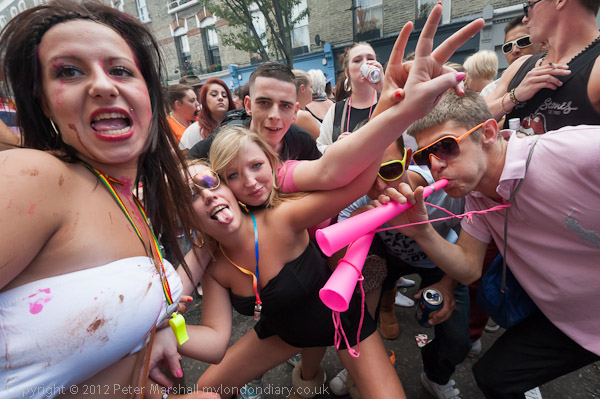
Dancers in All Saints Rd
more pictures
Since I first went to carnival around 1990, I've gone almost every year - except for one year when I was having knee problems only got as far as my local station before I collapsed in pain and had to acknowledge I wasn't going to be dancing that year.
But either I'm getting too old for it, or perhaps carnival is changing,
and this year I found it a little difficult. So I went on the Sunday,
stayed around three hours and didn't really want to return for the big
day. So I didn't.
more pictures
Shoreditch Art
Shoreditch, London. Sun 26 Aug 2012
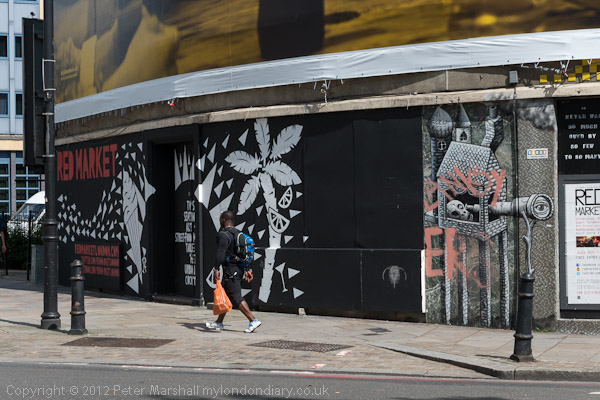
What used to be the Foundry now has the Red Market
iin the open space behind
more pictures
I got off the underground at Old St, and noticed as I walked out of the station and through the arcade under the roundabout that the steps leading up were open, so I went up and took a few pictures. I first photographed up here some years ago, before the new buildings around the roundabout. I'd not gone to Shoreditch to photograph the graffiti, but ended up doing so, as well as a few other pictures around the streets.
A large group which seemed mainly to be of foreign tourists was being
given a conducted tour and lecture of Blackall St while I was there, and
I had to wait around a bit for them to move along, so I had time to take
plenty of pictures.
more pictures
March Against Gangs, Guns and Knifes
Leyton - Walthamstow. Fri 24 Aug 2012
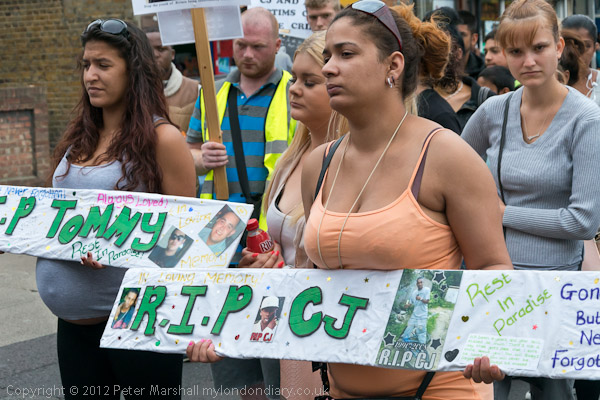
At the front of the march: Placards for CJ
Hendricks and Thomas Overton, killed the Sunday before the march.
more pictures
Several hundred marched from Leyton to a rally at Walthamstow Central in memory of C J Hendricks and others affected by serious youth violence and gang issues to a rally where young people performed and paid tribute to those who have been killed.
Police in 2011 investigated 155 incidents of stabbing in the London Borough of Waltham Forest, in north-east London, though fortunately few of them were fatal, though I'm not sure if the police report of only 2 fatalities tells the whole story. This year has seen at least two deaths already, with a man stabbed in May and another, Tommy Overton, aged 18, in Beaumont Road early last Sunday, August 19th. But the 2011 figures possible represent a drop in knife crime, as in the year between between April 2008 and March 2009 there were 544 'knife related incidents.'
Another teenager who lived on the Beaumont Estate, Michael Simon Wright, also known as 'Sezmic', only 17, was stabbed outside Maryland Station by one of his friends in 2009. The Beaumont Estate in Leyton, the largest estate in the borough has a poor record, often linked with the Beaumont Crew gang who see it as their territory.
Four years ago today, Charles Junior "CJ" Hendricks, aged 18, died after being knifed in Walthamstow, close to the site of today's rally. He was England's 24th teenage street murder victim. His family set up the 'CJ Hendricks Trust Fund' to raise money for a memorial headstone and to use any remaining donations to help youth projects in Waltham Forest. His father, Charles Hendricks Snr, wrote to then PM Gordon Brown, asking for more direct action to prevent knife crime. Two months later the Home Office launched their anti-knife campaign "It Doesn't Have to Happen".
Around 200 people gathered at Abbots Park in Leyton for the mile and a half march to Walthamstow Central Square this afternoon. Among them were many family members and friends of 'CJ', 'Tommy' and 'Sezmic', and it was very much a community event, with people of all ages and representing the ethnic diversity of the area.
Led my a car with CJ's mother Melanie Hendricks as a passenger, the march struck a brisk pace along Hoe St, with police clearing traffic. Many of those taking part carried placards, including some showing a 'hoodie' dropping his knife and gun into dustbins. There were t-shirts with a picture of CJ on the front, and on the back the message 'Don't cry because it's over ... smile because it happened...' an anonymmous proverb that has been attributed to both Gabriel García Márquez and Dr. Seuss, which reflected the mood of the event.
At the rally everyone was urged to give thanks for what these young men had shown in their short lives, to praise their memories and to remember them. There was a highly emotional atmosphere, with passionate 'a cappella' rap performances from several young men who were friends of the murder victims, and when one man, Ryan, moved from rapping to an intense gospel inspired vocal, there were few entirely dry eyes around.
Earlier we had heard Cllr Ali who said that Waltham Forest Council, unlike some other councils acknowledged that the area had a problem, and that their "honesty has enabled us to ... work with partners and community members to build our programe which is called 'Enough is Enough'" and to take active steps to deal with the problem. Some of those active steps were explained by one of the organisers of the event, Nicky Wilson.
But perhaps the mood of the event was summed up by a hand-written text on one of the posters carried at the head of the march, with pictures of CJ, which simply read:
Rest in Paradise - Gone But Never Forgotten.
"It's been 4 years and yor sitll missed so much! There's not a day that goes past that I don't think about you! You will always be loved & you will never be forgotten & always be missed!"
Sean Rigg Memorial - 4 Years
Brixton, London. Tue 21 Aug 2012
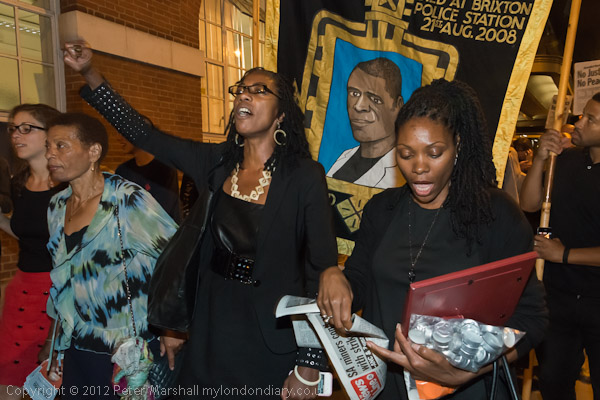
Sean Rigg's family with Mona Donle at the start
of the march to Brixton Police Station
more pictures
Every seat in the Assembly Hall at Lambeth Town Hall was full for the Sean Rigg Memorial, four years to the day after his death shortly after he was taken to Brixton Police Station. By the time the event inside had finished there were more around the sides of the hall and another fifty or so waiting for the march and vigil after.
Sean Rigg's death at the hands of police and the attempt by the Met and the IPCC to cover up the circumstances of his death has been brought out into the public eye by the determined Sean Rigg Justice & Change Campaign led by his two sisters, Marcia Rigg-Samuel and Samantha Rigg-David, supported by the rest of Sean's family, including his mother and organisations including Inquest, Black Mental Health UK and the United Families and Friends Campaign.
The recent high-profile inquest on Sean's death made far clearer what happened in the last few hours of his life, but continued to fail to bring either the full truth or justice. As the family say, the pain they feel "has been completely compounded by officers at best misleading the jury and lying under oath. The evidence we have heard has left us in no doubt that Sean died as a result of the wilful neglect of those who were meant to care for him and keep him alive."
This lack of care began with the failure of the South London and Maudsley Trust (SLaM) to do their job properly, and was compounded by the police failure to respond to repeated 999 calls from the hostel where Sean was living and take him to hospital. Instead, when police finally came they forcibly restrained him, arrested him for stealing his own passport, bundled him into a police van and sped him to Brixton Police Station, where he died on the concrete floor of a caged area at the rear of the station, surrounded by police officers.
Many of the facts of the case only came to light as a result of persistent and repeated enquiries by the family, with the police being more concerned about writing misleading press releases and the IPCC showing itself incapable of conducting interviews with the officers concerned, collecting appropriate evidence or asking questions. The 50 minute film 'Who Polices the Police' directed by Ken Fero of Migrant Media shown at the end of the evening included interviews with the IPCC in which they appeared to regard themselves as being more a PR department for the police than a proper investigative body. The IPPC decision to commission an independent external review of its investigation into the death of Sean Rigg perhaps reflects a feeling that in this case it failed to reach its normal level of competence - and the frustration of some in the organisation at the limitations imposed on it by statute.
Sean Rigg's case has been kept in the public eye because of the efforts of the family-led campaign, but is only one of hundreds or thousands of similar cases, few of which get more than a single paragraph in the mass media before they are forgotten. Some of the other more high profile cases were mentioned during the event, and the mother and sister of Olaseni (Seni) Lewis, a 23 year old who had just started a Masters Degree in IT and Business Management at Kingston University spoke briefly. Seni A few hours after being admitted as a voluntary patient to the Bethlem Royal Hospital in Beckenham (part of SLaM) Seni was taken to Croydon's Mayday Hospital in Croydon in a coma after being forcibly restrained by up to seven police. He died four days later on 4 September 2010.
Among those who spoke during the evening were Sam Rigg-David and Marcia Rigg from the Sean Rigg Justice and Change Campaign, Matilda MacAttram of Black Mental Health UK, Estelle Du Bulay from the Newham Monitoring Project, Weyman Bennett of the UAF and the RMT union and Glenroy Watson also from the RMT. There were also a number of contributions from the floor, some voicing the anger against the police felt by many, particularly in the black community.
There were two uniformed police who had attended the event, and I think one or two in plain clothes. Although some in the Met had good intentions in particular following the Stephen Lawrence inquiry, the changes that were made following this appear to have resulted in changes in reporting and not to have seriously challenged the blatant racism that still exists in the force, particularly at the lower levels.
Last Sunday, 19 August, another incident took place locally when police
violently assaulted an individual in Windrush Square outside Brixton
Library, with three officers arresting a man who was clearly disturbed
and acting unpredictably. Mona Donle, a Brixton resident was quoted on a
blog:
"One officer choked him by holding his forearm across the man’s throat.
Then another officer stamped on him. The foot was on his face and then
the man passed out – we kept telling them to call an ambulance."
Another eye-witness told me last night that the man had the clear
impression of the boot across his face and that it was around 20 minutes
before the man came round.
The police account reads differently, making no mention of the violence and suggesting that the ambulance arrived 'approximately' five minutes after the arrest.
After the meeting, around 200 people joined in a march behind the Sean Rigg Campaign banner from the town hall to Brixton Police Station, where flowers were laid at the memorial tree outside, candles lit and a minute's silence held for Sean Rigg and other victims of police violence.
Samantha Rigg and Mona Donle then took a formal complaint into the police station, and after a second or two were followed in by a crowd, packing out the small lobby. Police there made a copy of the complaint and then gave the complainants a signed and dated copy. They asked to see the officer in charge, and after a few minutes he came to a side door and answered what questions he was able to about Sunday's arrest.
I had to leave at this point, but it seemed as if the event was about
to end.
more pictures
Solidarity with Marikana Miners
London. Sat 18 Aug 2012
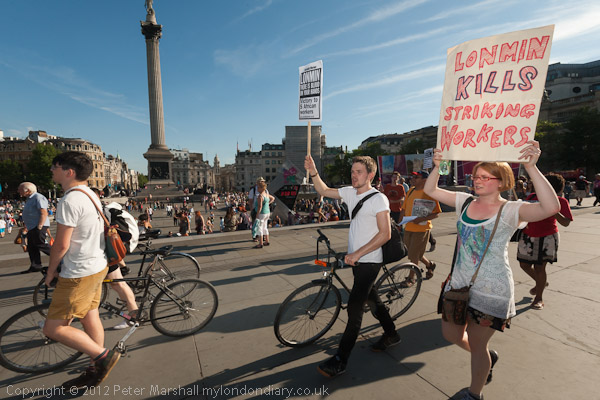
Protesters gathered outside Lonmin's offices and
marched to South Africa House.
more pictures
Around 50 people protested at short notice over the shooting of striking miners at the Marikana platinum mine by police in South Africa. After protesting outside the London offices of Lonmin, they marched to South Africa house for a short rally.
The shooting by South African police of the striking miners appalled many around the world, and as the news broke an emergency protest was called for Saturday afternoon outside the London offices on Lonmin, the owner of the mine.
Lonmin, previously even more infamous as Lonrho, has a small suite of offices on the top floor of a recently refurbished office building near Hyde Park Corner. Nothing on the outside of the building or the parts of the lobby visible through the windows tells you of the company's presence, and the offices were firmly locked and apparently completely empty when the protesters arrived.
The group stood on the pavement in front of the building, waving placards at the constant flow of traffic on the busy junction and the steady stream of passers-by for around an hour before deciding to march to South Africa House to end the protest with a rally there.
Their route took them across Green Park and up into the Mall, still in a terrible mess after the Olympics, which forced them to exit into Pall Mall to continue their journey.
At South Africa House we listened to a socialist from Zimbabwe who told both of her disgust at what had happened at Marikana, and also how it fitted in to the pattern of exploitation and oppression that has characterised the mining industry in Africa. Conditions in many of the mines are terrible, with little or no attention to health and safety issues, and miners are on low wages.
The older trade unions, linked through COSATU to the ruling ANC
government are seen by many as doing little to improve pay and
conditions for miners, many of whom, as at Marikana, are now joining the
more militant and recently formed AMCU.
more pictures
EDL Outnumbered in Chelmsford
Chelmsford, Essex. Sat 18 Aug 2012
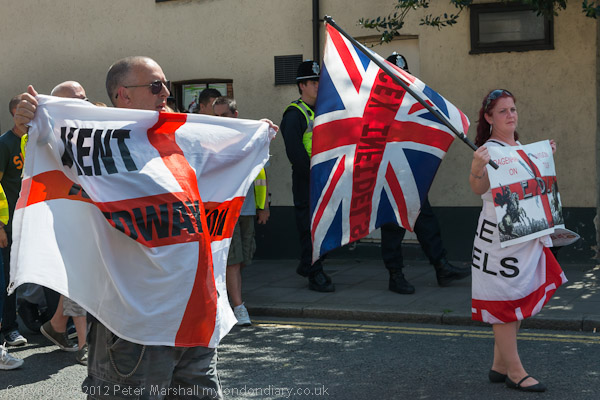
Dramatic light on the EDL - but few in the march
more pictures
The EDL marched in Chelmsford, Essex against plans to build a large mosque in the city. They were opposed by roughly 3 times as many supporters of Chelmsford Against Racism. A heavy police presence kept the city peaceful during the marches.
The English Defence League (EDL) were marching to show their opposition against the plans for a large mosque in the city. They were opposed by a counter-demonstration roughly three times as large by Chelmsford Against Fascism and the UAF (United Against Fascism.)
The city was crowded with police both to keep these two groups apart but also to deal with the very much larger crowds heading for the 'V' festival in a nearby park.
I started by briefly photographing the UAF rally in the centre of the city before making my way to the pub a quarter mile away, closer to the site of the planned mosque, where the EDL were gathering. There were roughly 80 of them, filling the small pub and its beer garden opposite the police station. Facing the pub when I arrived were a row of police horses, and there were more officers around it on foot. I started to photograph some of the EDL through the railings around the beer garden and was abused by one of those inside. He complained to police who assured him that I was acting lawfully. Others inside the beer garden posed for me, making 'V' signs and other gestures for the camera. When I had taken a few pictures an officer requested I move away to avoid further upsetting the marchers, and as I had already taken my pictures I was happy to do so.
Next I photographed the EDL Essex Division spokesman Paul Pitt as he was being interviewed for TV. His performance, polite and smiling, gave a rather different impression to those supporters I had just been photographing.
Pitt stated that the EDL were not opposed to any building of mosques, but that the size and location of the proposed building was unsuitable. He denied that the EDL were racist and said that they represented the views of local people who had invited them to march in Chelmsford.
He went on to comment on the counter-demonstrators, saying that the "UAF and Unite are here to silence us", and that one EDL supporter who had been intending to speak at the rally had withdrawn as he was a Unite member, and had he been recognised would have lost his job. He went on to say that today's event would be "a strong positive march" but that "there will be no violence from us."
A few minutes later the march formed up in the street at the side of the pub behind several banners. There was some singing of well-known EDL songs, including one about Muslim Bombers, and as the march started, a rather large and fat marcher came towards me as I was taking pictures and said: "I hope all your family die of cancer."
I followed the EDL march, taking pictures until it turned down the street where the rally was to take place. There was a huge police presence, with vans from other forces including Norfolk, with various fences and cordons across roads to ensure that the EDL and the counter demonstration were kept apart.
I returned to the UAF counter-protest in the middle of the busy shopping area. The rally had been going on there for almost two hours and now were lined up ready to march. As soon as the police had sealed off the street containing the EDL rally they were allowed to start their march, led by Weymann Bennett of the UAF, on a route that took them around the area where the EDL were meeting.
It was a very different march to that by the EDL, with over three times as many people - well over 200 - and many more placards and banners. It was also considerably louder, with almost continuous chanting calling for an end to the racist provocations of the EDL, though usually rather less politely.
The only incident I saw came when two EDL supporters came to the roadside and began to loudly shout 'EDL!, EDL!' For a few moments I didn't realise anything was happening, as many of the UAF chants had begun with 'EDL!' though followed in their case by 'Go To Hell!' or some similar comment.Police were quick to drag the two men away to a seat away from the march, where they held them until it was past and told them not to interfere with it again.
Although the EDL managed to hold their march, it was a small event and
went around the outskirts of the centre, seen by very few. The UAF and
others held a long meeting right in the centre of the shopping area with
much greater support, and clearly were far more successful and widely
supported.
more pictures
Al Quds Day March
Portland Place - US Embassy, London. Fri 17 Aug 2012
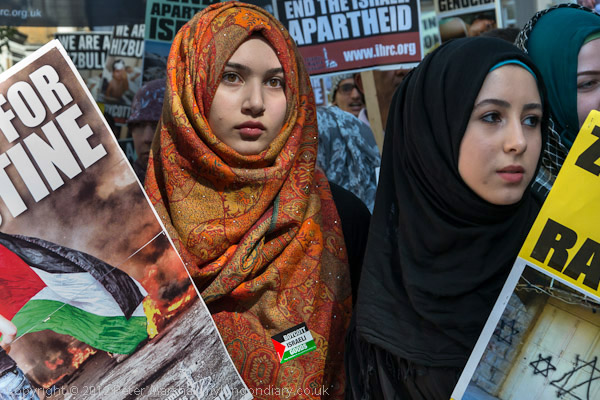
Young women wait for the march to start
more pictures
Back in 1979, the year of the Islamic revolution in Iran, Ayotollah Khomeini invited "Muslims all over the globe to consecrate the last Friday of the holy month of Ramadan as Al-Quds Day and to proclaim the international solidarity of Muslims in support of the legitimate rights of the Muslim people of Palestine." At the start of the following year, the Jerusalem Committee of the Organisation of Islamic Cooperation, the largest international body apart from the UN, with 57 member states rerpresenting the Muslim world decided that Quds day would be celebrated around the world.
Major celebrations take place particularly in countries with significant Shia populations, including Lebanon, where they are ogranised by Hezbollah, but Quds Dau is also celebrated in Gaza by Hamas, a Sunni political party.
In Iran, the day is organised by the government, and in 2009 became the focus for demonstrations by opposition groups against President Ahmadinejad after the disputed election there.
The annual march in London had been taking place with realtively little controversy for many years, but in 2007 there were small but noisy protests by Iranian communists and royalists at Piccadilly Circus. The march in London is organised by the the Islamic Human Rights Commission (IHRC), which is thought to be sponsored by and promoting the Iranian regime and right-wing fundamentalist Islam. Although many applaud much of its research and campaigning work - including its support for the Palestinian cause - its links with Iran cause many to criticise it or not wish to be closely involved with it.
The following year there were more groups protesting, including the extreme right United British Alliance and March for England, International Alliance of Iranian Students, the Worker Communist Party of Iran, Workers Liberty and a group of Zionists waving Israeli flags.
In 2009, after the protests in Iran and the killing of Neda Agha-Soltan the Iranian democrats joined the protests, as well as the communists and royalists, but the main group of protesters - and probably the only group in double figures were from the EDL and related groups. Both the EDL and the Iranian greens staged slightly larger protests in 2010, now including a 'Jewish Division' of the EDL. Marchers (and I) narrowly escaped serious injury when a two thirds full beer can was thown across Park Lane into the march.
The same two groups also protested against the march in 2011, though on a slightly smaller scale, with a few minor incidents around Trafalgar Square where the march ended that year.
I saw no evidence of any counter-protests during this years march, despite the event having been widely advertised on London's buses. It was held on the actual Quds day, (as always a Friday) while previous marches have taken place on a Saturday or Sunday. The organisers had worried that this might impact on the numbers taking part. My careful count as the march went past me in Mayfair showed that slightly over 2000 people taking part, a little down on some previous years but fairly typical for the event.
There were a few marchers with placards or photographs of Khomeini on the march, and a small number carried or wore Hezbollah flags, and many placards also were from Hezbollah. But although this started as a small Iran trained Shia military group, dedicated to the removal of Israel from Lebanon, listed by the UK as a terrorist group, and still receiving aid from Iran, it is now a much wider organisation, holding a third of the cabinet seats in the Lebanese government and running a TV station and social development programs.
The slogans chanted on the march were the familiar ones of all Palestinian protests, with perhaps the most popular being 'From the River to the Sea, Palestine will be free.'
There were one or two short halts on the march outside businesses which support Israel and its occupation of Palestine where the marchers shouted chants of shame, and along the route they gave out s short illustrated leaflet that explained the protest and invited everyone to the rally "where speakers from all communities, including a Rabbi, will talk about Palestine." On the reverse it had a cartoon about a woman's experiences living on the West Bank under Israeli occupation. It told a story that mirrored that suffered by one of my friends who went out to live in Palestine a few years ago, when Israeli settlers came to destroy his village's crops, with the Israeli army giving them protection, and the leaflet ended with a call to boycott Israeli goods.
Although organised by the IHRC, many other groups support the march, including the Stop the War Coalition and the Muslim Association of Britain and Muslim Council of Britain and . Among the banners and t-shirts were those of many campaigns supporting the Palestinian cause including Bin Veolia, Boycott Israeli Blood Diamonds, Show Israeli Apartheid the Red Card, Don't Dance with Israeli Apartheid, Boycott M&S Campaign, Palestine Solidarity Campaign ...
Prominent in the march as on previous occasions were the anti-Zionist
Jews of Neturei Karta UK, one of whom spoke at the rally outside the US
Embassy. The first speaker after a recitation from the Koran was the
Anglican Rev Stephen Sizer who gave us a short sermon about our Quds Day
wishes for Jerusalem, suggesting that 'if we wish to do God’s will, we
will work and pray for Al Quds to become an inclusive city that reflects
God’s vision, a city of justice, peace and reconciliation.' It was a
sentiment greeted with loud applause.
more pictures
Ecuador's Embassy & John Massey
Hans Crescent, Knightsbridge, London. Fri 17 Aug 2012
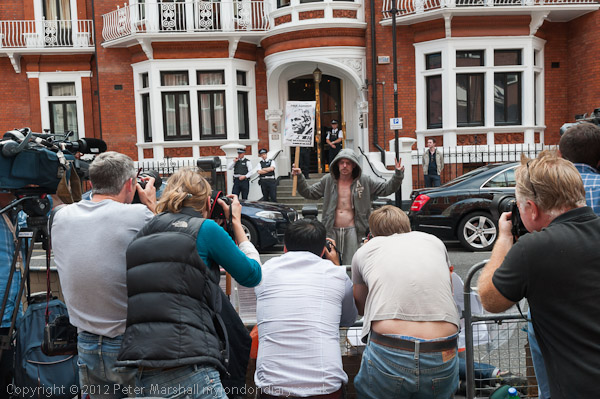
Photographers, protester and police outside the
Ecuadorian (and Colombian) Embassy
more pictures
There wasn't a great deal happening when I dropped by the Ecuadorian embassy, where Julian Assange was somewhere inside, but keeping away from the windows. Only the ground floor to the left of the doorway is the Ecuadorian embassy, and on the previous night the police had turned up in force as if they were about to storm it - following Foreign Secretary William Hague's note saying we might - but had apparently only entered the non-embassy areas of the building, as yet avoiding the major diplomatic own goal that would result from the disregard of the Vienna convention - and one which legal opinion (which Hague decided to ignor) appears to think would be judged illegal under UK law.
The police are one of three groups staking out the embassy - there were perhaps around 50 of them visible - a large and almost entirely wasted cost. The world's media were also there in force, with TV camera after TV camera, their crews largely sitting around with nothing to do, and a horde of still photographers.
The smallest group were the protesters - who don't get paid to be there. Quite a few of them were still at the Pussy Riot protest and expected to return later. The few who were there put on a little theatre for the cameras while I was there, though few of the TV crews took any notice.
As well as Assange, there have been other protests taking advantage of the media presence, including a call for the release of one of the UK's longest serving prisoners. In 1975 John Massey used a sawn-off shotgun to murder nightclub bouncer Charlie Higgins who had gouged out the eye of one of his friends with a broken glass, and the following year he got a life sentence. The judge said he should serve at least 20 years.
Massey was allowed a home visit in 1994, having served 18 years, and took the chance to escape, living for 3 years in hiding on the Costa Del Sol before being brought back to a British jail.
In 2007 he was again going to be released, and even had a job waiting for him, but the authorities refused to let him go home, insisting on him staying at a hostel in Streatham. He made a hospital visit to his dying father in the Royal Free Hospital in Hampstead, stopping off on his way back to Streatham for a drink at the Fiddlers Elbow in Kentish Town. He had asked for an extension of his curfew for the hospital visit, but this had been refused. A massive police search was mounted for him, with helicopters and at least one door being knocked down by police. When police officers came to the pub he gave himself up and was taken back to jail.
By 2010 he was in Ford open prison near Chichester, when he heard that his sister was dying. He walked out of jail and went to visit her bedside and then went to live openly at his mother's house in Camden. It was 10 months before the police bothered to come an collect him and retun him to a secure prison. He was sent to Pentonville, locked up for 23 hours a day and heavily medicated.
A parole board decision this February that he still represented a danger to the public and should be kept locked up for at least 3 more years is inexplicable, and according to the case decision of which the Guardian has a copy, appears to have been made in ignorance of Massey's circumstances. Given that he committed no crimes in the periods he was out of prison this seems inexplicable.
In June this year, Massey again made the headlines when he climbed over the wall of Pentonville. His escape made the national news, and he was described as 'potentially dangerous' and people were warned not to approach him. He was arrested 2 days later in Kent.
Massey has served his time - and shown remorse - for his orginal crime; as he asked in an interview with The Guardian 'why he should remain in prison for being a "loving son and brother".'
But perhaps Julian Assange should take some lessons from John Massey
about escaping from tricky positions! I hope both of them are soon free.
more pictures
Free Pussy Riot
Bayswater Road, London. Fri 17 Aug 2012
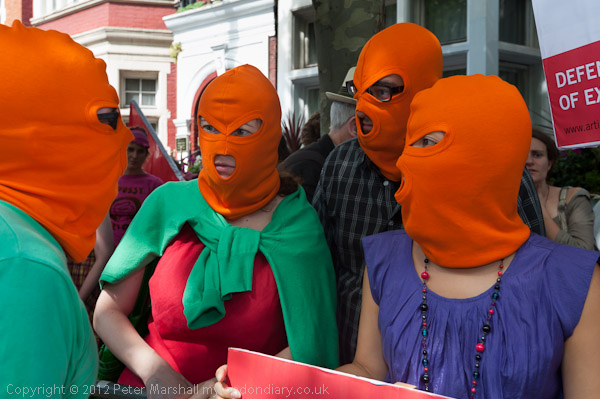
Protesters in orange hoods call for freedom for
Pussy Riot
more pictures
There was a noisy protest close to the Russian embassy, with many in brightly coloured hoods or balaclavas to condemn the political trial in Moscow of the 3 Pussy Riot members on the day the verdict and the sentence of two years hard labour was announced in the court.
The embassy is down a private street, Kensington Palace Gardens, where
no protests and no photography are allowed, but the embassy also own a
building at the top of this street with a frontage on Bayswater Rd,
opposite which the protest took place. There were around a hundred
protesters, many dressed appropriately for the occasion. I left shortly
after the sentence was posted on Twitter and those taking part had
expressed their disgust.
more pictures
Battersea Riverside
Battersea, London. Tue 14 Aug 2012
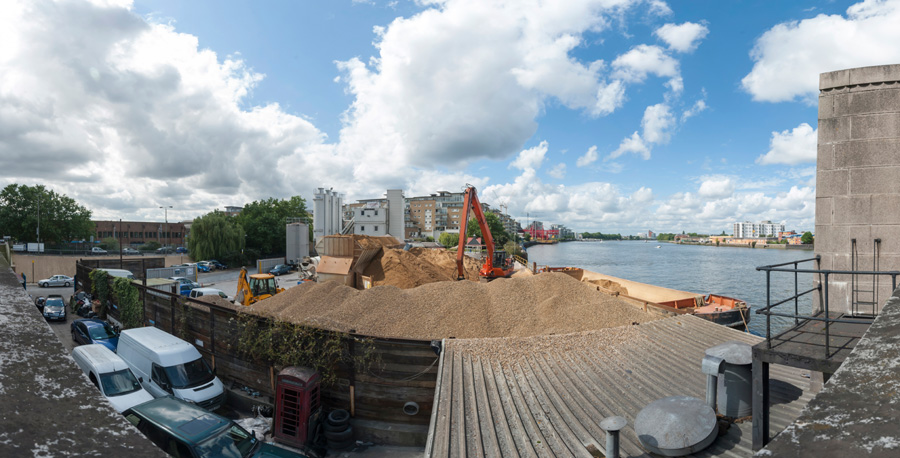
Sand and gravel at Wandsworth
more pictures
It was a nice day and I had an hour or two to spare, so I took a walk
from Battersea Bridge to Wandsworth along the Thames Path. It's a
riverside that has changed pretty dramatically in the past 30 years,
with little remaining of the industry that lined most of the south bank
of the River Thames. Every time I walk it a little more has gone with a
new block of flats or hotel or other luxury development. But a few
things remain.
more pictures
Hizb ut-Tahrir Supports Rohingya Muslims
Bangladesh High Commission, London. Sat 11 Aug 2012
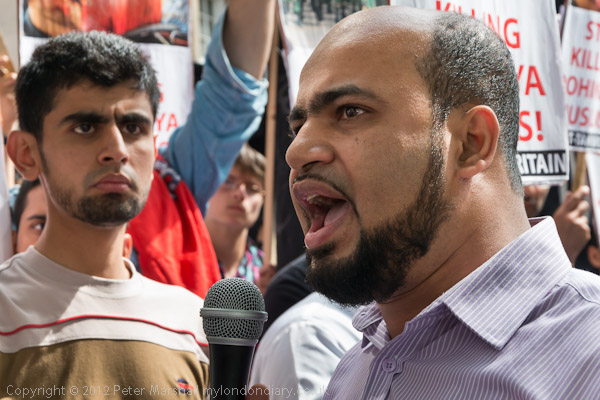
Speakers stressed the Muslim identity, the 'Ummah'
and the need for an Islamic Khalifah
more pictures
Hizb ut-Tahrir UK organised a large protest opposite the Bangladesh High Commission against the blocking of aid to Rohingya refugees by NGOs and their policy of sending them back to be oppressed in Myanmar (Burma.)
Approaching a thousand Hizb ut-Tahrir UK supporters had turned up for the protest opposite the High Commission in Kensington and they formed an impressive mass on the pavement opposite with placards and Islamic flags.
They listened attentively to the Hizb ut-Tahrir speakers, including the UK media director, Taji Mustafa, Liaquot Sharker, Mujibul Islam, and Dr Abdul Wahid. Sharker, a member of Hizb ut-Tahrir's Bangal committee spoke in Bengali but the other speakers I heard were in English.
The crowd responed lustily with chanting of support and slogans including
"Muslim Ummah, one Ummah"
"Open borders to the Rohingya Muslims"
The event began with a speaker saying that we had been unaware of the Muslims in Myanmar until news began to leak out about their oppression, with terrible stories of rapes and killings, and that there was a terrible hypocrisy in the way the Western media reported events in Myanmar. It's true there has been little in our papers, but the same is true of media in the Muslim world.
Although our press has long paid great attention to the plight of Aung San Suu Kyi until recently the media and Western governments had ignored what was happening to minority tribal groups in Myanmar, including the Muslim Rohingya and the Karen. The story of the Rohingya, who have been persecuted since Burma became independent, only really emerged in the Western press recently when three interational NGOs working in Bangladesh, Médecins Sans Frontières (MSF), Action Against Hunger (ACF) and Muslim Aid UK, were ordered by the Bangladesh government to stop giving aid to Rohingya refugees in Bangladesh.
The leader of the Rohingya Solidarity Organization of Myanmar (RSO), speaking in Pakistan, has alleged that the Bangladesh government has issued orders to its troops to shoot Rohingya refugees entering their country, and there are other reports of them being handed back to the Myanmar authorities.
Arakan or Rakhine, the western coastal state of Myanmar, was an independent kingdom for several thousand years before becoming part of Burma in 1874. Later it came under British rule as a part of India in the days of empire and was transferred to Burma again in 1942. Roughly 25% of its inhabitants are Rohingya Muslims, and these 3/4 million people are described by the UN as one of the world's most persecuted minorities. In 1970 the Burmese military government stripped them of their citizenship, giving them 'Foreign Registration Cards'.
There is a long history of Rohingya refugees fleeing to Bangladesh, and settling in the south-east coastal area around Cox's Bazaar, and of repeated attempts by Bangladesh to repatriate them to Myanmar, with a number of agreements betweent the governments over the years which have been largely inneffectual.
The current violence in Rakhine State between Buddhist Rakhine, Muslim Rakhine, and Muslim Rohingya is said by the RSO to have started on May 28, following the conversion to Islam and marriage to a Muslim man of a Buddhist girl; the Buddhist community then stopped a bus containing Muslim pilgrims and killed some of them and the violence spread. On 10 June, the Myanmar government declared a state of emergency and sent in the Border Security force, army and police to Rohingya areas and, according to Amnesty International, "Hundreds of mostly men and boys have been detained, with nearly all held incommunicado, and some subjected to ill-treatment."
Amnesty has also received reports of "other human rights abuses against Rohingyas and other Rakhine Muslims– including physical abuse, rape, destruction of property, and unlawful killings – carried out by both Rakhine Buddhists and security forces." Some details were given of incidents, particularly those involving attacks on Muslim women, at today's protest.
Hizb ut-Tahrir call for Muslims to stand united against such persecution and see the only war to prevent such abuses as the formation of an Islamic Khalifah - their organisation's aim of a united Islamic state. But the idea of the 'Ummah' which underlies this and today's protest is one that transcends nations and national identities with a religious identity.
The protest today was outside the Bangladesh High Commission, and Bangladesh has a roughly 90% Muslim population. Formed out of British India at Partition in 1947 as a Muslim state of East Pakistan, after it gained independence in 1971 adopted in 1972 a secular democratic constitution. The secular principle was contradicted by a presidential decree when the country was under martial law in 1975-7 but was restored in 2010 under the current Prime Minister Sheikh Hasina, who was featured on a number of the placards at the protest for her government's actions against the Rohingya.
Sheikh Hasina has been the target of earlier protests by Hizb ut-Tahrir
Britain in which they have called for an end to the 'fascist
dictatorship' of the Awami League, which they regard as "anti-state,
anti-Islam and anti-people" and its replacement by an Islamic Khilafah
which they say is the only way to ensure the safety and security of the
country, the people, and Islam.
more pictures
London Eye
Waterloo, London. Wed 8 Aug 2012
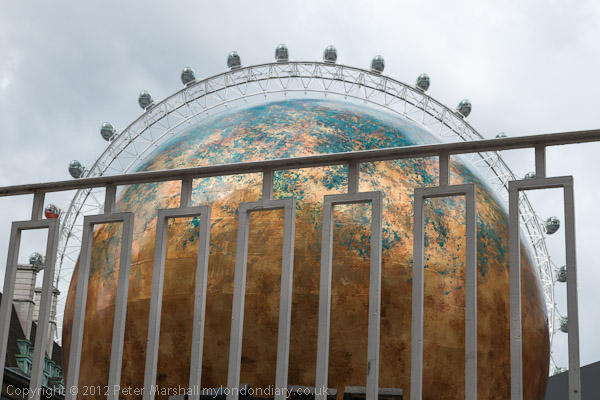
Just a slightly different picture of the London Eye.
I was rushing to catch my train home when I thought this might be an interesting picture, though very tricky to get it lined up exactly. But as much as anything I was amused by the copyright problems it might embody. I only took the one frame, but perhaps another day when I have more time I might retake it more precisely, although it looked more or less right in the viewfinder - where the image is just a little small for this kind of thing.
Unions Continue Fight For Remploy Workers
Dept of Work and Pensions, Westminster, London. Wed 8 Aug 2012
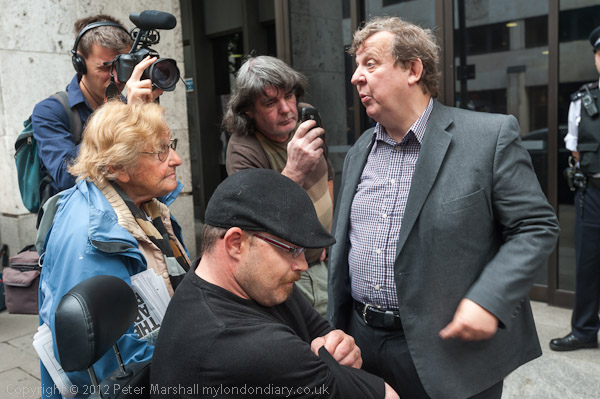
Phil Davies, Remploy Consortium secretary argues with activists over
the trade union actions
more pictures
A protest outside the Dept of Work and Pensions in Westminster stressed the determination by the unions to continue to fight to save the jobs of the disabled workers employed by Remploy.
On 2 August, the Remploy Consortium of trade unions, which includes the GMB, Unite and Community, suspended the strike due to take place on Monday 6 August to hold consultations with their members over further actions and to discuss Remploy's Individual Consultation meetingss and Accord and greivance procedure at factory meetings on the Monday 6 or Tuesday 7 August.
They intend to set up regional Remploy Support Groups in every town and city and to call for demonstrations in London and other city centres to step up the fight.
A special Olympic flyer stresses 'We are NOT going for GOLD, We are condemned to DOLE' over the top of the five 'Olympic' rings of Unemployment, Ill Health, Discrimination, Death and Poverty and the message 'Stop. Stop the closure of Remploy factory sites.'
Remploy announced on 10 July that it was talking with bidders for 9 of the factories and a business which it proposed to close. The remaining 27 factories and its Boston Spa operations will end later this year. They say the closures 'will put at risk 1421 jobs in those factories and in central departments'. The union puts the figure around a hundred higher.
Remploy was set up to provide jobs for servicemen injured in WW2, and most of the workers for which it provides employment will find it difficult or impossible to find jobs elsewhere. Not because they do not have skills, but because they need the support that Remploy uniquely provides, enabling them to produce useful products.
The myths put about by Conservative politicians such as minister Mr Duncan Smith, who when he met Remploy workers at the House of Commons disgracefuly said “Is it a kindness to stick people in some factory where they are not doing any work at all? Just making cups of coffee?” are simply untrue.
The workers at Remploy do skilled work producing useful products such as furniture, circuit boards, windows and doors, leading edge chemical and biological and nuclear protective suits, wheelchairs and other mobility products, packaging, printing, and more. According to Remploy, their products are sold to 'the Police, high street retailers, leading vehicle manufacturers, banks, Government and thousands of hospitals and schools' among others.
The factories the Government wants to close are loss-making, although the losses are perhaps small in relation to the benefits. The unions have proposed changes that would greatly cut costs at Remploy by cutting down the layers of non-disabled management involved. They also point out that closing down the factories will end in costing the government more in benefits from the workers, most of whom will fail to find other work. The previous Labour government closed 29 Remploy factories in 2008, and 85% of the workers made redundant then are still on benefits.
The only group who will benefit from the closures are the asset strippers who get a cut-price deal from the government on the factories, who have been given a promise by the government that they will pay in full the cost of redundancy payments for the disabled workers.
Around 40 people came to the protest outside the DWP offices in Westminster, including Phil Davies, the Secretary of the Remploy Consortium and Kevin Hepworth, its Chair. This had not been intended to be a mass public demonstration, but just a small group including the officers and a Remploy worker, who would have gone into the offices and delivered their demands. But details of the event were published on Facebook and in the left-wing press, and a number of supporters with banners, placards and literature stalls, along with a small police presence turned up.
During the protest some of the supporters argued strongly with Phil Davies that the GMB and other unions were not putting their full weight behind the campaign, and that the strike should not have been called off. He disagreed vehemently, and made clear that it was the Remploy workers who were leading the actions and that they fully supported the actions of the union consortium. Some of the protesters were insistent that the workers should take direct action and be urged to occupy their workplaces, but, as Kevin Hepworth pointed out, our far-reaching trade union legislation made it impossible for unions to officially support more radical actions - they would simply have their property sequestrated.
After an hour and a half standing around outside the doorway of the
DWP, the protesters began to drift off, and I left too.
more pictures
Iraq Day Festival
Queen's Walk, South Bank, London. Sat 4 Aug 2012
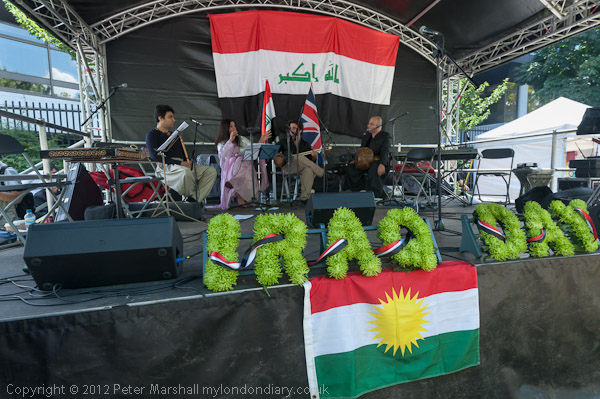
The stage with Iraq and Kurdistan flags and a
Kurdistan group performing
more pictures
The Iraq Day 2012 was "organized to celebrate the games with a hint of Iraq flavor" by the Iraqi Culture Centre in London and sponsored by Bayt Al Hekima- Baghdad in conjunction with Local Leader London 2012 program.
It aimed to build stronger relationship among British-Iraqi communities and to entertain those who are curious about the the rich cultural heritage of Iraq including its music, food and art and to promote tourism to the country.
It was an afternoon of sunshine and showers, and the event to some extent mirrored this, with some disagreements between those taking part over the programme. I watched as one of the performers stormed off the platform, furious at what she felt was cultural discrimination against the Kurds, and the fashion show I had been asked to photograph and was told would be taking place in two minutes just didn't happen before I went home almost an hour later after loud and bitter argument between its director and the organisers.
So although there were some interesting things happening, there were also disappointments. For many of the Iraqis attending the biggest disappointment was that this event was taking place during Ramadan and they were thus unable to eat the Iraqi food on offer.
Many of the thousands of people who walk along by the Thames stopped at
least for a few minutes to look and listen, but there could perhaps have
been more to detain them. I would have stayed longer but I had other
stories to write and file.
more pictures
Raoul Wallenberg 100th Anniversary
Great Cumberland Place, London. Sat 4 Aug 2012
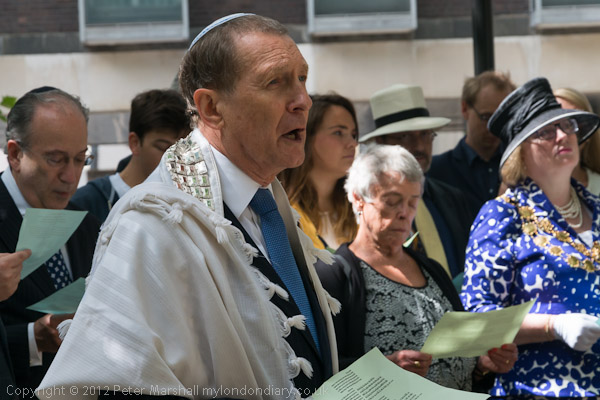
Rabbi Lionel Rosenfeld and leading the chanting of
a Psalm in Hebrew at the thanksgiving
more pictures
Raoul Wallenberg, one of the great heroes of the twentieth centry who as by his efforts as a Swedish diplomat in Budapest saved over 100,000 Hungarian Jews from Nazi death camps was remembered today at ceremonies around the world.
In London, a short ceremony took place at the monument erected to him in 1997 in Great Cumberland Place, outside the Western Marble Arch Synagogue. It was led by Rabbi Lionel Rosenfeld and many of those present were from the synagogue as well as the Lord Mayor of Westminster and the Swedish Ambassador and some from the Swedish Church in London.
Three psalms were read in thanksgiving for the life of Raoul Wallenenberg, with Rector Michael Persson from the Swedish Church in London reading Psalm 121 in English, and the others were recited by most of those present in Hebrew. Psalm 121, which begins 'I will lift up my eyes to the hills; from where my help may come? My help comes from the LORD, Maker of heaven and earth. He will not let your foot stumble...' and was described on the service sheet as 'One of the great expressions of trust in God's protection, often recited in times of trouble.'
Rector Persson then talked about Wallenberg, who he called 'an average man' who grew up in a banking family but was too sensible, too friendly and too nice to be a banker and so became a businessman. Faced with the situation of thousands of Jews being sent to their death in Hungary he did everything he could to help, an ordinary man who was brave when the time came, one of Sweden's greatest heroes.
Wallenberg had followed the Lutheran ideal of living, a calling to be yourself and to do good for other people.
Wreaths were laid at the foot of the fine statue of Wallenberg erected here in 1997. By sculptor Philip Jackson, it shows Wallenberg standing in front a a large wall with his name inscribed high on it. The wall is made of stacks of the roughly 100,000 very official looking 'protective passports' he issued identifying the bearer as Swedish subjects awaiting repatriation. Although these had no legal status, they looked impressive and, sometimes with the aid of a little bribery, saved the bearers from deportation. The 4m high statue is a moving piece of work in a fine setting (by Donal Insall Associates), arguably Jackson's finest work. Another copy of it is in Buenos Aires.
The Lord Mayor of Westminster, Councillor Angela Harvey, and Swedish Ambassador Ms Nicola Clase also spoke at the event and Mrs Jill Blonsky, volunteer of the Wallenberg Foundation reminded us of the need to find the truth about the death of Wallenberg after his imprisonment by the Russians; new information is coming to light and it may be that one day we will know more about how and when he died.
At the end of the event there was a performance by a choir from the
Swedish church.
more pictures
Adidas Stop Your Olympic Exploitation
Adidas, Oxford St, London. Sat 4 Aug 2012
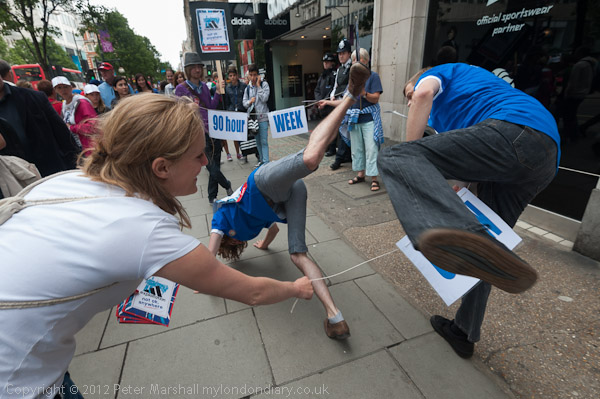
War on Want athletes tackle hurdles of poverty
wages, union busting and 90 hour week faced by workers who make Adidas
sportwear outside the official Olympic sportswear partner's flagship
store on Oxford St.
more pictures
War on Want handed out leaflets and played games outside Adidas on Oxford St, claiming that workers making clothes for the official sportswear partner of London 2012 get poverty wages are not allowed to form unions and have little or no job security.
The protesters started by handing out leaflets to shoppers in the busy street outside Adidas's main store in Oxford Street, watched by around 20 police. Many of those passing, took the leaflets and some, including several with Olympic passes, stopped to talk and express their disgust at the exploitation of foreign workers.
War on Want say:
Around the world thousands of workers, mainly women, producing clothes for Adidas are not paid enough to live. There wages do not cover basic essentials like housing, food, educatin and healthcare.
With such low wages, workers have to work excessive hours just to scrape together enough to get by, sometimes beyond legal limits - up to 15 hours a day.
In many cases workers are told that if they try to organise trade unions to defend their rights, they face harassment or they will be fired.
Since the protest was taking place on one of the busiest days of the London games, the protesters had come prepared to play some games in their protest. They started with badminton, using a banner as the net, in front of the main entrance to Adidas, but the mid-Scottish police on duty in Oxford St soon objected to that as they thought it might be dangerous to passers-by. The protesters moved on a little, but the police still didn't like it, and they had to go into the quiet turning on the west side of the shop, just ten yards from busy Oxford St, to continue the game, which became rather more competitive than some at the Olympics.
After Badminton came a short hurdles event, with 2 runners making their way over the hurdles of 'POVERTY WAGES', 'UNION BUSTING' and '90 HOUR WEEK'. After a few preliminary runs in the side street they moved onto Oxford St, where the police let them play for a few minutes before telling them it had to stop. Adidas were unhappy about it as a part of the pavement nearest the store - which formed half of the hurdles course - was their property.
I left them after more than an hour of protest outside Adidas still handing out leaflets inviting people to fill in a Freepost postcard to Herbert Hainer, the CEO of Adidas, care of War on Want, calling for Adidas to end the exploitation of workers.
Someone from the PR agency acting for Adidas approached me as I was preparing to photograph the event, and later she sent me a statement, starting with the paragraph:
"adidas respects the right to peaceful protest but we strongly refute War on Want’s claims. We take all allegations about working conditions extremely seriously but it is very important to note that the independent women’s NGO Phulki, which visits our factories on a monthly basis, found absolutely no evidence to support the allegations being made."
Even more important is to note that Phulki is only active in Bangladesh, and the specific claims made by War on Want on their web site relate to wages and conditions in factories in Indonesia, Sri Lanka and China producing goods for Adidas.
War on Want are not an organisation that makes claims without the evidence to back them, and in many other cases companies making claims such as those by Adidas have been shown to be very happily allowing their partners to pull the wool over their eyes so long as their profits are high. Adidas is only one of many doubtful sponsors backed by LOCOG, which has also shown itself to be blind to the activities of Dow, Atos, BP and all the others.
The PR statement continued by stating that "The adidas Group is fully committed to protecting worker rights and to ensuring fair and safe working conditions in factories throughout our global supply chain." and claimed that it had tried to contact War on Want to discuss the claims they are making - presumably including those of workers being paid 34 pence an hour - but had been unable to do so.
The following day, after another protest against Adidas on the edge of
the Olympic site, War on Want published a press release with links to
the cases on which they based their claims, and stressed that they had
taken part in discussions with Adidas, "but the multinational
continues to deny the widespread nature of the problems and has failed
to respond to the organisation’s demands that the firm commits to
paying a living wage."
more pictures
top of page
All pictures on this section of the site are Copyright © Peter Marshall 2012; to buy prints or for permission to reproduce pictures or to comment on this site, or for any other questions, contact me.

